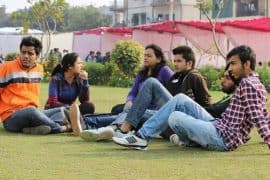Education, literacy and entrance examinations have always been a subject of popular debate in our country, with thousands of students aspiring every year to get through some of the best educational institutes of the country, like the IITs, NITs, AIIMS, etc. The Indian Institute of Technology Joint Entrance Examination (IIT-JEE) has always been an elusive examination for most students, with lakhs of students preparing every year to attain the coveted tag of being an IITian, with only 1% getting through. The IIT JEE examination is considered the toughest engineering entrance examination inAsia, and those who crack it pride themselves in doing so.
In May 2012, the Union Human Resource Development (HRD) Minister, Kapil Sibal announced a revamp of the IIT JEE examination, with the inclusion of all the major engineering entrance examinations of the country into one single examination- Indian Science Engineering Eligibility Test (ISEET). The new pattern consisted of two examinations- the ISEET Main and the ISEET Advanced. The top 40,000 students of the ISEET Main examination would be allowed to appear for the ISEET Advanced, which granted admission to the premier institutes of engineering like the IIT’s and NIT’s. However, ranks would be determined by taking 50% of the score of the advanced examination and 50% of the class 12 board examination results.
This proposal had earlier been pending in the Parliament, but was passed this May, causing uproar throughout the country. Students as well as parents protested against the inclusion of the class 12 board examination marks and the IIT senates immediately condemned this decision of the government. IIT Delhi moved the High court two weeks after the declaration of this decree. IITKanpurmoved a step ahead and announced its very own entrance test from 2013.
Amidst this entire confusion, there were hotly contested debates on various public forums, with writers like Chetan Bhagat and Directors of ‘prestigious’ coaching institutes condemning the decision to include the class 12 board marks and they labelled this move as an attempt to lower the standard of the IIT’s, which are the pride of India. The IIT senates felt extremely insulted by this impeachment on their autonomy. A student studying in a coaching centre in Mumbai said, “ I took a drop after my class 12 to prepare for IIT JEE, and I hadn’t fared very well in my boards as I was busy preparing for IIT JEE. Now that the pattern has changed, does the government expect me to go back and give my class 12 boards again? Before, cracking the JEE was important. Now, if class 12 marks determine our ranks, then where will students who have taken a gap year go?”
However, the Director of the Vidyalankar group of coaching classes felt that this decision was a wise move. With coaching classes branching out all over the country, IIT JEE had become an examination for conditioned mindsets, not academic brilliance. With the implementation of the ISEET, students would become more serious about attending school and performing well in the boards. The practice of integrated school- cum- coaching classes like Bansals and Narayana would soon disappear and students could again go back and enjoy their school days – something they deserved and which they should not be averse to. He also added that his coaching centre offers coaching for both class 12 and IIT JEE. Looks like business strategies are changing as fast as the education system.
With increasing dissent all over the country and a complete deadlock over the course of the future of thousands of children sitting for the entrance examination in 2013, Kapil Sibal organized a meeting with the IIT directors and finally came to a consensus about the pattern of the ISEET examination. The proposal for 50% weightage on class 12 board marks was scrapped and it was decided that students in the top 20% of their board would be allowed to sit for ISEET Advanced. The number of students eligible to sit for ISEET Advanced now increased to 1,50,000. The agitation slowly died down, as the decision makers came to a consensus without taking the views of the children into account, which is usually always the case when it comes to education. Take the implementation of the semester system inDelhiUniversityas an example.
With the ISEET implemented, the students still haven’t received any intimation in regard to the pattern of the new exam and are still in the loop about whether their board marks will be scaled down while assessing their ranks or not. We can now just wait and watch the outcome of this new exam- a political gimmick, most people say, before the 2014 elections. Whether it will be a huge disaster like the National Eligibility cum Entrance Test for medicine (NEET), which was a complete failure last year, or a success…only time will tell.





Comments are closed.